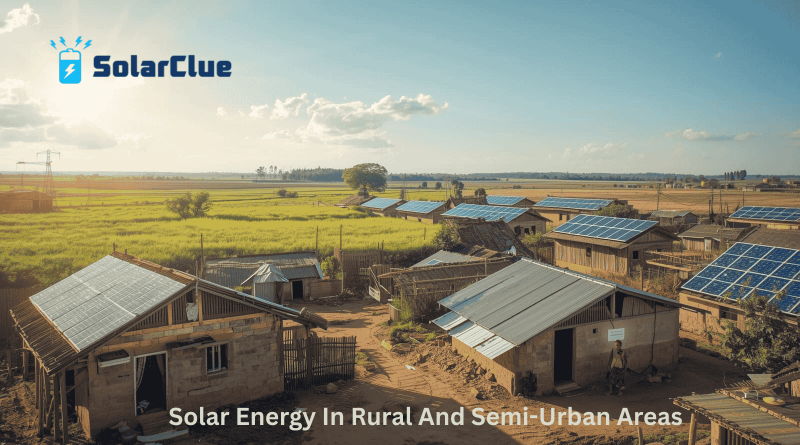Solar Energy in Rural and Semi-Urban Areas: Opportunities, Challenges, and the Way Forward
As the world transitions toward renewable energy, solar power is at the forefront of this clean energy revolution. While urban areas are already witnessing rapid rooftop solar adoption, rural and semi-urban regions represent the true untapped potential for large-scale impact.
These areas often struggle with irregular or no electricity access, hampering education, healthcare, and livelihood opportunities. By leveraging solar energy in rural areas, we can bridge the energy divide, empower communities, and accelerate sustainable development.
Table of Contents
Potential of Solar Energy in Rural and Semi-Urban Areas
Abundant Solar Resources
Rural India and similar regions worldwide are blessed with high solar irradiation due to open landscapes and clear skies. Unlike dense urban centers, land availability in rural areas makes large-scale solar farms and decentralized systems more feasible and cost-effective.
-
Agriculture-focused solutions: Solar-powered irrigation pumps reduce reliance on diesel, cutting costs and emissions.
-
Community mini-grids: Solar microgrids can supply entire villages, avoiding the cost of extending the national grid.
-
Industrial benefits: Rural industries such as food processing and handicrafts gain uninterrupted electricity for growth.
Reducing Energy Poverty
Access to affordable, reliable power is directly linked to improved quality of life. Solar energy enables:
-
Better healthcare facilities, especially refrigeration for vaccines and reliable lighting for clinics.
-
Education improvements through access to digital learning tools and evening study lights.
-
Growth of local entrepreneurship as small shops, workshops, and internet kiosks can function without frequent power cuts.
By reducing energy poverty, solar systems become a tool for social and economic empowerment.
Government Push and Incentives
Governments across the globe, especially in countries like India, are actively promoting rural solar adoption through multiple initiatives:
-
Capital subsidies & tax benefits: Lower the overall cost burden for households and cooperatives.
-
Low-interest financing: Rural banks and microfinance institutions make solar systems affordable.
-
Net metering policies: Allow households to sell surplus solar energy back to the grid, turning villagers into prosumers (producers + consumers).
-
Flagship programs: Schemes such as the Indian government’s PM-KUSUM promote solar irrigation and decentralized power.
Challenges in Expanding Solar Energy
Despite the promising potential, widespread adoption of solar energy in rural and semi-urban areas faces several hurdles.
High Upfront Costs
Solar installations, though cost-effective in the long run, require high initial capital investment. For low-income households and farmers, this becomes a major barrier.
Solutions:
-
Microfinancing models and pay-as-you-go solar kits make systems accessible without heavy upfront costs.
-
Community solar cooperatives allow pooled investments where households share infrastructure and benefits.
Limited Awareness and Technical Skills
Many rural communities lack awareness about the long-term benefits of solar or fear that maintenance will be difficult.
Solutions:
-
Establish local training centers to skill youth in solar installation and maintenance.
-
Run community awareness drives to showcase real-life benefits of solar adoption.
Infrastructure and Supply Chain Gaps
Transporting equipment and ensuring availability of spare parts in remote areas remain significant challenges. Without reliable after-sales service, rural users hesitate to invest.
Solutions:
-
Create rural solar hubs with storage, repair, and distribution facilities.
-
Partner with local entrepreneurs to establish service centers close to villages.
Policy and Regulatory Barriers
Unclear policies, delayed subsidy disbursement, and excessive paperwork discourage adoption.
Solutions:
-
Streamline subsidy processes through digital platforms for faster disbursal.
-
Enforce clear, consistent regulations that promote trust in solar adoption.
Strategies and Way Forward
To accelerate solar adoption in rural and semi-urban regions, a multi-pronged strategy is required:
-
Decentralized Solutions: Encourage rooftop solar, mini-grids, and stand-alone solar pumps.
-
Public-Private Partnerships: Leverage government funding with private innovation to scale impact.
-
Technology Integration: Use IoT-based smart meters and digital monitoring to ensure system reliability.
-
Community Engagement: Work with local leaders, cooperatives, and NGOs to build trust.
-
Skill Development: Train rural youth as solar technicians to generate employment alongside adoption.
These measures ensure solar power is not just introduced but sustainably maintained in rural areas.
Conclusion
Solar energy represents a transformative opportunity for rural and semi-urban communities. By addressing challenges such as financing, awareness, and infrastructure, these regions can become hubs of clean energy innovation.
Expanding solar adoption will:
-
Close the energy access gap,
-
Boost economic development,
-
Support climate goals, and
-
Empower rural communities with sustainable livelihoods.
The way forward lies in collaborative efforts between governments, private players, and local communities to unlock the full potential of solar energy in rural and semi-urban areas.



